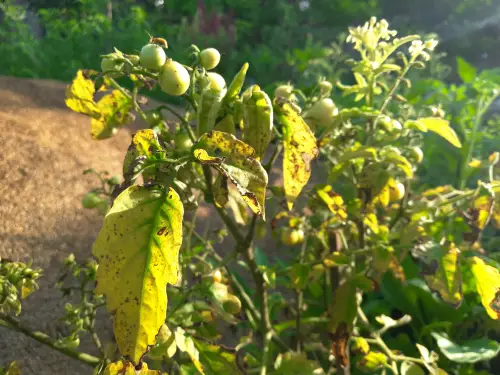Tomato plants are a popular option for gardeners, as they are relatively easy to grow and produce delicious fruits. However, it can be devastating for tomato plants dying from the bottom up. This is a common problem that many gardeners face, and there are several reasons why it can happen.
One of the most common reasons why tomato plants die from the bottom up is due to disease. Tomatoes are disease-resistant, but if the soil is contaminated, it can be a great source of diseases.
Other factors that can cause tomato plants to die from the bottom up include a lack of sunlight, nutrient deficiencies, extreme heat, damage from transplanting, and pests. It is important to recognize the symptoms of unhealthy tomato plants to prevent the problem from getting worse.
Key Takeaways on Tomato Plants Dying From The Bottom
- Tomato plants can die from the bottom up due to disease, lack of sunlight, nutrient deficiencies, extreme heat, damage from transplanting, and pests.
- Recognizing the symptoms of unhealthy tomato plants is important to prevent the problem from getting worse.
- Proper cultivation practices and prevention techniques can help to keep tomato plants healthy and prevent problems from occurring.
See how to revive your other dying plants:
Recognizing Symptoms of Unhealthy Tomato Plants
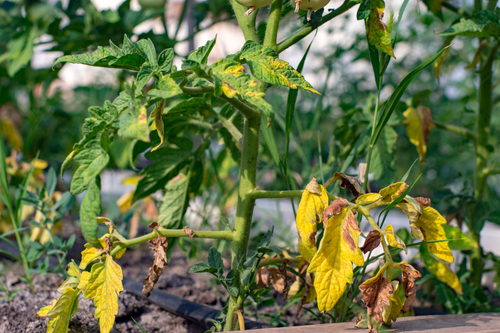
Tomato plants are a popular choice for gardeners and farmers alike, but they can be susceptible to a variety of problems. One common issue is when tomato plants start dying from the bottom up.
This can be a frustrating problem to deal with, but it is important to recognize the symptoms of unhealthy tomato plants so that you can take action quickly.
1. Turning Brown
One of the most obvious signs of an unhealthy tomato plant is when the leaves start turning brown. This can be a sign of a variety of problems, including fungal diseases, root rot, or simply a lack of water. If the leaves are turning brown from the bottom up, it is likely that the plant is suffering from a problem with the roots.
2. Dying from the Bottom Up
When a tomato plant starts dying from the bottom up, it is a sign that the roots are not functioning properly. This can be due to a variety of factors, including poor soil quality, overwatering, or a lack of nutrients. If you notice that the leaves are turning yellow and falling off, it is likely that the plant is not getting enough nutrients.
3. Wilting
Another common symptom of an unhealthy tomato plant is wilting. This can be a sign of a variety of problems, including a lack of water, fungal diseases, or pests. If the leaves are wilting from the bottom up, it is likely that the roots are not functioning properly and the plant is not getting enough water.
4. Stunted Growth
If your tomato plants are not growing as quickly as they should be, it could be a sign of an underlying problem. This could be due to a lack of nutrients, poor soil quality, or a fungal disease. If the plants are stunted from the bottom up, it is likely that the roots are not functioning properly.
Common Diseases and Pests
Tomato plants are susceptible to a variety of diseases and pests that can cause them to die from the bottom up. Identifying and treating these issues early is crucial to preventing the spread of the disease and saving the plant. In this section, we will discuss some of the most common fungal and bacterial diseases as well as pests that affect tomato plants.
Fungal Diseases
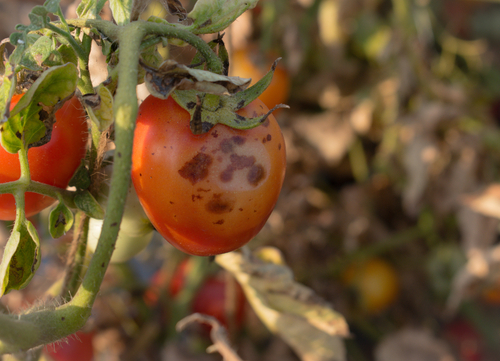
Fungal diseases are some of the most common diseases that affect tomato plants. They are caused by soil-borne fungi that thrive in warm, moist conditions. Some of the most common fungal diseases that affect tomato plants include early blight, late blight, fusarium wilt, and verticillium wilt.
Early blight is a fungal disease that affects the leaves of tomato plants. It causes circular, brown spots to appear on the lower leaves of the plant. As the disease progresses, the spots will expand and the leaves will turn yellow and eventually die.
Late blight is another fungal disease that affects the leaves and fruit of tomato plants. It causes brown, water-soaked lesions to appear on the leaves and fruit, which can quickly lead to plant death.
Fusarium wilt and verticillium wilt are both fungal diseases that affect the roots of tomato plants. They cause the plants to wilt and die, starting from the bottom up. These diseases can persist in the soil for several years, so it is important to rotate crops to prevent them from spreading.
Bacterial Diseases
Bacterial diseases are less common than fungal diseases but can be just as devastating to tomato plants. Bacterial diseases are usually spread by insects or through contaminated soil or plant debris. Some of the most common bacterial diseases that affect tomato plants include bacterial canker and bacterial wilt.
Bacterial canker is a disease that affects the stems and leaves of tomato plants. It causes the leaves to turn yellow and the stems to develop dark, sunken lesions. Bacterial wilt is a disease that affects the roots of tomato plants. It causes the plants to wilt and die, starting from the bottom up.
Pests
Pests can also cause tomato plants to die from the bottom up. Some of the most common pests that affect tomato plants include aphids, tomato hornworms, and spider mites.
Aphids are small, sap-sucking insects that can quickly infest tomato plants. They can cause the leaves to curl and turn yellow, and they can also transmit viral diseases. Tomato hornworms are large caterpillars that can quickly defoliate a tomato plant. Spider mites are tiny pests that feed on the leaves of tomato plants, causing them to turn yellow and eventually die.
Nutrient Deficiencies
Tomato plants require a variety of nutrients to grow and thrive. Nutrient deficiencies can cause leaves to yellow and curl, stunt plant growth, and lead to the death of the plant. In this section, we will explore two common nutrient-related causes of tomato plants dying from the bottom up: lack of nutrients and nutrient imbalance.
Lack of Nutrients
One common cause of tomato plants dying from the bottom up is a lack of nutrients. In particular, a lack of nitrogen, phosphorus, and potassium can cause the lower leaves of the plant to yellow and die off.
Nitrogen is essential for leaf growth, while phosphorus is important for root development and flower production. Potassium helps regulate water movement within the plant.
If a lack of nutrients is suspected, a soil test can help identify which nutrients are deficient. To address a lack of nutrients, gardeners can add fertilizer to the soil.
Nitrogen-rich fertilizers can help address a lack of nitrogen, while phosphorus-rich fertilizers can help address a lack of phosphorus. Potassium-rich fertilizers can help address a lack of potassium. However, it is important not to over-fertilize, as this can lead to nutrient imbalances.
Nutrient Imbalance

Another cause of tomato plants dying from the bottom up is nutrient imbalance. Nutrient imbalances can occur when plants receive too much of one nutrient and not enough of another.
For example, a calcium deficiency can cause blossom end rot, which can lead to the death of the plant. However, too much calcium can lead to a magnesium deficiency.
To address nutrient imbalances, it is important to identify which nutrients are out of balance. A soil test can help identify nutrient imbalances. Gardeners can then adjust their fertilizer application to address the imbalance. It is important to follow fertilizer application instructions carefully and to avoid over-fertilizing.
Environmental Factors
When tomato plants start dying from the bottom up, it could be due to environmental factors. There are a few things to consider when it comes to environmental factors, including watering issues, sunlight and heat, and soil conditions.
Watering Issues
Water is essential for tomato plants to grow, but overwatering or underwatering can lead to problems. Uneven watering can also cause issues, so it’s important to water tomato plants evenly.
Watering tomato plants too much can lead to root rot, while insufficient water can cause the leaves to wilt and turn yellow. It’s recommended to water tomato plants deeply once a week, rather than giving them frequent light watering.
Sunlight and Heat
Tomatoes need plenty of sunlight to grow and produce fruit. Lack of sunlight can cause stunted growth and unhealthy plants. Direct sunlight is best, but if the plants are in an area with extreme heat, they may need some shade.
Shade cloth can be used to protect the plants from the sun’s intense heat. It’s important to note that tomatoes need full sun for at least six hours a day to produce fruit.
Soil Conditions
Soil pH, cold soil, and high humidity can all affect tomato plants. Soil pH should be between 6.0 and 6.8 for optimal growth. Cold soil can stunt growth and cause nutrient deficiencies, so it’s important to wait until the soil has warmed up before planting tomatoes.
High humidity can lead to soil diseases, such as early blight and late blight. It’s recommended to do a soil test to check the pH and nutrient levels before planting tomatoes.
Cultivation Practices
When it comes to growing healthy tomato plants, cultivation practices play a crucial role. Below are some of the practices that can help prevent tomato plants from dying from the bottom up.
1. Pruning
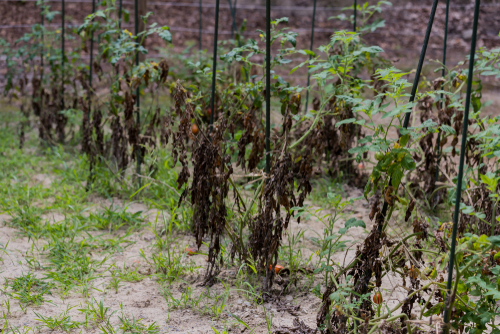
Pruning is an essential practice that can help prevent tomato plants from dying from the bottom up. It involves removing the suckers, which are the shoots that grow between the main stem and the branches.
Suckers can reduce the plant’s energy, leading to reduced fruit production. Pruning also helps increase air circulation and light penetration, which can help prevent diseases.
2. Crop Rotation
Crop rotation is another essential practice that can help prevent tomato plants from dying from the bottom up. It involves planting tomatoes in a different location each year to prevent soil-borne diseases from building up. Crop rotation also helps improve soil fertility and reduce the risk of pest infestations.
3. Container Gardening
If you don’t have enough space to grow tomatoes in the ground, container gardening is an excellent alternative. Growing tomatoes in pots can help prevent diseases, as you can control the soil quality and drainage. Additionally, container gardening allows you to move the plants to different locations to optimize sunlight exposure.
When growing tomatoes in containers, it is essential to use a potting mix that is well-draining and nutrient-rich. You should also ensure that the container is large enough to accommodate the plant’s root system.
In addition to the above practices, it is also crucial to ensure that tomato plants receive adequate sunlight, water, and nutrients. Proper pollination is also essential for fruit production, so it is recommended to plant flowers that attract pollinators near your tomato plants.
If you are growing self-pollinating tomato varieties, you can also use a small brush to transfer pollen between flowers to ensure fruit set.
Preventing Tomato Plant Problems
Tomato plants are susceptible to a variety of problems, including pests, diseases, and environmental stressors. However, there are steps gardeners can take to prevent these issues and keep their tomato plants healthy and productive.
1. Choosing Disease-Resistant Varieties
One of the best ways to prevent tomato plant problems is to choose disease-resistant varieties. Many tomato varieties have been bred to resist common diseases such as verticillium and fusarium wilt, early and late blight, and nematodes. When selecting tomato plants, look for varieties that are labeled as resistant to these diseases.
2. Maintaining Healthy Soil
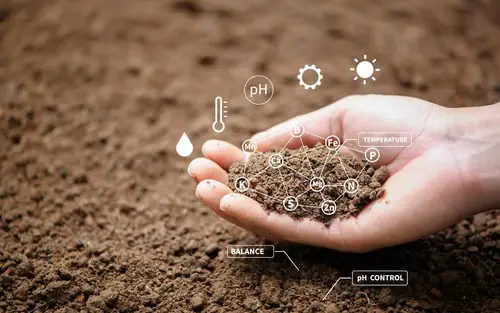
Healthy soil is essential for growing healthy tomato plants. To maintain healthy soil, gardeners should regularly add organic matter such as compost or well-rotted manure.
This will improve soil structure, increase water-holding capacity, and provide nutrients for plants. Additionally, gardeners should avoid planting tomatoes in the same spot year after year, as this can lead to a buildup of soil-borne diseases such as root rot.
3. Proper Watering and Feeding
Tomatoes require consistent watering and feeding to thrive. Gardeners should water tomato plants deeply and regularly, aiming to keep the soil evenly moist but not waterlogged. Inconsistent watering can lead to problems such as blossom end rot and cracking.
Additionally, tomatoes require regular fertilization to produce healthy foliage and fruit. Gardeners can use a balanced fertilizer or add epsom salt to the soil to provide magnesium, which is essential for tomato growth.
Conclusion
There are several reasons why tomato plants may die from the bottom up. These include fungal diseases such as Fusarium wilt and Verticillium wilt, bacterial diseases such as bacterial canker, and environmental factors such as overwatering, poor soil drainage, and lack of sunlight.
It is important to identify the cause of the problem early on to prevent it from spreading to other plants. Gardeners should practice good sanitation, such as removing and destroying infected plants and avoiding planting tomatoes in the same spot for at least three years.
Proper care and maintenance of tomato plants can also help prevent problems. This includes providing adequate sunlight, watering correctly, and fertilizing appropriately. Gardeners should also monitor their plants regularly for signs of pests and diseases and take action as soon as possible.
Frequently Asked Questions
What causes the leaves on tomato plants to turn yellow from the bottom up?
Yellowing of leaves on tomato plants from the bottom up is a common sign of a fungal disease called Fusarium wilt. This disease is caused by a soil-borne fungus that attacks the roots of the tomato plant, restricting the flow of water and nutrients. As a result, the leaves start to turn yellow and wilt, starting from the bottom of the plant.
How do you prevent fungal wilt in tomato plants?
Preventing fungal wilt in tomato plants involves taking several measures. One of the best ways is to plant resistant tomato varieties. You should also avoid planting tomatoes in the same spot every year, as this increases the risk of soil-borne diseases.
Additionally, ensure that the soil is well-draining, and avoid overwatering the plants. Finally, practice good garden hygiene by removing any infected plants and debris from the garden.
What is the best way to save a dying tomato plant?
The best way to save a dying tomato plant is to identify the cause of the problem and take corrective action. If the plant is suffering from a fungal disease, it’s best to remove it from the garden to prevent the spread of the disease.
If the plant is overwatered, reduce the amount of water it receives. If the plant is underwatered, increase the amount of water it receives. Additionally, ensure that the plant is getting enough sunlight and nutrients.
Why do tomato plants die before the fruit ripens?
There are several reasons why tomato plants may die before the fruit ripens. One reason is a lack of nutrients, particularly calcium. Another reason may be a lack of water or too much water.
Additionally, the plant may be infected with a disease or pest. Finally, the plant may be too old and past its prime.
How can you tell if a tomato plant is overwatered?
Overwatering tomato plants can lead to several problems, including root rot, fungal diseases, and wilting. One way to tell if a tomato plant is overwatered is to check the soil. If the soil feels waterlogged and the plant is wilting, it’s a sign that the plant is getting too much water.
Additionally, yellowing leaves and stunted growth may also be signs of overwatering.
What are the signs that a tomato plant is dying from the top down?
Tomato plants that are dying from the top down may be suffering from a disease or pest infestation. One common disease that causes this symptom is bacterial canker.
This disease causes the leaves to turn brown and wilt, starting from the top of the plant. Another possible cause is a pest infestation, such as spider mites or aphids. Finally, the plant may be suffering from a nutrient deficiency, particularly nitrogen.

Hey, I’m Lisa and I’ve been an avid gardener for over 30 years. I love writing, talking and living in the garden! Feel free to connect with me on my socials below

